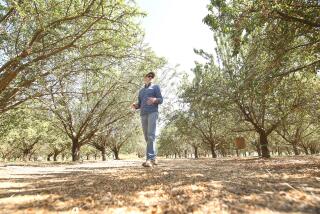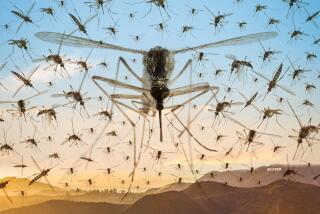Fly-by-Night Back-Yard Lab Yields Scientific Surprises : Research: Tracking local moths allows a Connecticut scientist to fill gaps in the knowledge of wildlife and forecast potential climate changes.
- Share via
HAMPTON, Conn. — Pinned to the back of David and Sylvia Wagner’s home here was an old white bedsheet. On this summer night it served as both an instrument of science and a bulletin board for some of Connecticut’s most overlooked creatures.
It was a clear, dry night, the katydids grinding away in the woods, producing the rasping soundtrack of summer. A powerful mercury vapor light hanging in front of the sheet attracted hundreds of bugs. They fluttered about and, often enough, lobbed themselves onto the wall of white.
David Wagner was watching; so was his 6-year-old daughter, Virginia, who at one point knowingly called attention to a sly little moth at the upper edge of the sheet. Its wings tucked in, it looked like a fresh bird dropping.
It was one moth’s way to fool predators. “They all have to have some sort of gimmick,” Wagner said.
There were other moths that looked like sticks, some that looked like dead leaves. There was a bug with orange-and-black markings, a signal of poison in nature.
In all there were maybe 150 kinds of insects flying about, most of them moths, and it wasn’t even a big bug night, Wagner said. On a good night, a muggy night, he might have seen more than 400 species, he figured.
*
Over the last five years, in fact, Wagner, a scientist who specializes in the study of small moths, has counted 800 moth species in his back yard, approaching half of the 1,800 or so species that conceivably could be found in the entire state.
His work is yielding surprises. He has already discovered a potentially damaging moth heretofore not known to exist in North America, and he’s helping to fill in the many informational gaps wildlife managers have when it comes to understanding what is plentiful and what is not among Connecticut bugs.
“There is so much information we need to gather so we can make informed decisions about what is rare when it comes to invertebrates,” said Nancy Murray, coordinator of the state Department of Environmental Protection’s Natural Diversity Data Base, which oversees the protection of the state’s endangered and otherwise rare plants and animals.
The status of birds and plants is pretty well known, she said, “but we really don’t know the diversity of the invertebrate species we have in the state.”
“It’s the final frontier, almost,” she said.
*
It is such a frontier that Wagner’s grassy back yard, bounded by a pumpkin patch and a swing set, has so far yielded six species of moths previously unknown to science and many times that number of moths heretofore unknown in Connecticut.
Among his discoveries was the little moth Blastodacna hellerella. In Europe it damages apple crops, and the U.S. Department of Agriculture has been alerted to Wagner’s discovery.
Wagner, an assistant professor of ecology and evolutionary biology at the University of Connecticut, is among 10 invertebrate specialists advising the state on its new endangered species protection program, which most notably imposes restrictions on any activities by a government agency that would harm an endangered plant or animal.
“If I can find a species in my back yard that is on the endangered species list, or proposed for the list . . . then that species probably shouldn’t be on the list, because the habitat here is not unique,” he said.
Among other things, Wagner has found that some southern species, such as the serene underwing, are moving into the state. That can mean different things: It might mean, for example, that global warming is affecting what species find the state comfortable. On the other hand, that new arrival might even be natural, part of a long, slow process that began with the retreat of the last glacier.
The serene moth--its forewings are an ash and charcoal color, its hindwings orange and black--comes from a colorful family of moths with equally colorful names, including connubial underwing, wayward nymph and sordid underwing.
Wagner’s studies also can help document the decline of an insect. Already, scientists estimate that more than 30 insect species have been driven from the state, including three of the showiest: the royal walnut moth, the imperial moth and the regal fritillary.
Scientists believe that the regal fritillary, which was found on Block Island in Rhode Island as recently as last summer, has been driven from New England. It has not been seen in Connecticut in decades.
*
“There is some fairly good evidence that we lost some of our most spectacular insects because of DDT,” he said. “They disappeared about the time we had widespread applications of DDT in Connecticut.”
Even the more benign pesticides in use today often kill many more insect species than just those the poison is intended for. Wagner suggested that pesticides be used only when clearly necessary and not on a routine basis.
“With insects, you have to take the good with the bad,” he said. “You have to realize they are the little things that run the world. We can’t live with them; we can’t live without them. We require them for pollination, recycling and decomposition; they play tremendous roles there. There is a tremendous amount of insect-plant interactions that are very, very important. Everything would come to a grinding halt in a day without insects.”
Overhead, a bat was picking off its share of the moths lured by the mercury vapor light. Frogs and toads gathered under the sheet, among the roses, for their share. And the moths piled up.
A few feet away, Virginia and her brother, Ryan, 2, were showing a new friend their caterpillar cage, a literal larval menagerie of the next generation of bugs.
Among the creatures in the cage was the caterpillar of a spicebush swallowtail, a butterfly. As did some of its mature cousins, it disguised itself as a bird dropping as it climbed over leaves.
“Now, they have another line of defense. If a bird pecks them, watch what comes out of their face,” Wagner said. He poked the caterpillar, and a pair of horns emerged.
The spicebush swallowtail has yet another defense when it gets older and even larger.
Then it looks like a small snake.






